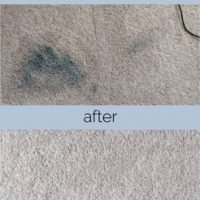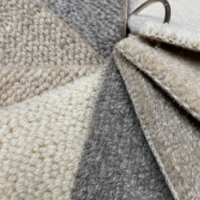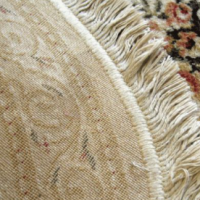Before buying a rug, you may want to know all about it. That is its durability, price, the rug materials used in the making, and all that.
In this case, we have acrylic and polyester. Both are synthetically made from plastic petroleum-based products but have different pros and cons.
Continue reading to learn more about this synthetic fiber rug and carpet.
What is Acrylic?
Acrylic is made from acrylic fibers, a synthetic material with a wool-like feel and look.
It is common in our shelves and homes as it makes rugs, warm clothing, and other knitted kinds of stuff.
Acrylic is popular in carpet and rug making due to their feature.
What is Polyester?
Polyester derives from a chemical reaction between petroleum-based alcohol and an acid.
It is also common in the clothing industries and rugs.
Comparison and differences between acrylic and polyester rugs
Prices
Both acrylic and polyester rugs are affordable compared to natural fibers like wool, cotton, and rayon. It is because they are made from cheap materials and are mass-produced.
Water resistance
Being synthetic, they can’t hold up water. So we can say that the two are resistant to water. As rugs, they are the best as they give no room for molds and odors.
They also get to be a good fit for the bathroom, kitchen, and dining room, where spillages occur.
Rug Quality
They both seem to be of good quality in their own right. The wool-like acrylic is fine, soft, and luxurious, likewise to the polyester.
Blending the two with other fibers also does improve their quality though acrylic blends well.
They are great for indoor and outdoor.
Maintenance and durability
Synthetic rugs are usually easy to maintain. The olefin, Acrylic, polyester, polypropylene, and nylon rug and carpet can all be machine washed, or you may spot clean. However, acrylic is prone to shrinkage when washed or dried, or exposed to high temperatures. On the other side polyester, retains its shape even in harsh conditions. But just like acrylic, it melts when exposed to high temperatures because they are plastic.
Polyester tends to be more durable than acrylic.
Versatility
Both synthetic materials are diverse in that they are used to make different products. We have the acrylic and polyester carpet sold indoors and outdoors. The clothing industries also got their share as they use this fabric for making both cold and warm weather clothes.
The acrylic yarns make socks, gloves, sweaters, scarves, tracksuits. Furthermore, it also mimics animal faux fur in some clothes, taking advantage of its wool nature.
It is a result of the hand-tufted acrylic, which provides more warmth.
Polyester makes jackets, and its smoother form makes Lining. It has good insulation.
Staining
Them Being synthetic, these rugs need to get washed regularly. They lack the chenille to hide dirt and dust and so vacuuming often helps maintain cleanliness.
Again they are resistant to stain but not oil-based as they can be stubborn at times to the synthetic rugs.
Reaction to sunlight
When exposed to direct sunlight, the acrylic rug will still maintain its status as it doesn’t fade whereas, the polyester is colorfast and so not a good idea for air-drying.
Nylon is also not good with UV rays.
Sustainability
The Polyester rugs are durable and last long though not like the polypropylene. They are also recycled and so are eco-friendly but compared to wool- it is not still good.
The Acrylic fabric has a short lifespan. It takes ages to decompose, and over the years, it releases toxic chemicals as it breaks down.
But Some people will still not buy the idea that the synthetic material rugs are safe for the pet and the surrounding, and will choose the natural fiber rugs over them.
Olefin versus polyester
Similar to polyester, olefin fabric is super cute with so many colors and designs. They are a great interior decoration.
They are both stain-resistant, and they dry fast since they do not absorb water.
Olefin rug is fade resistant, while the polyester carpet can’t stand the sunlight.
Both are durable and eco-friendly.
Polypropylene versus acrylic
Both are petroleum-based products.
They both have a wool-like feeling although, acrylic is much softer than the polypropylene rug.
The Acrylic fabric is more water-resistant than the polypropylene.
When it comes to durability, acrylic is more durable than polypropylene rug.
Polypropylene is less expensive than acrylic and polyester.
Acrylic versus nylon
Like acrylic, nylon fabric can withstand all weather conditions. Perfect for both indoors and outdoors.
Washing them is an easy task. The rugs are machine washable.
Nylon carpet is wrinkle-resistant.
The nylon doesn’t seem to absorb water well like the acrylic fiber.
Nylon makes the chiffon, satin, upholstery as well as knits.
FAQs
Do polyester rugs look cheap?
The polyester rug is like any other synthetic rug. It looks stylish.
Has a variety of patterns and colors as it can easily blend with other materials. Acrylic polyester is a good match, just like polyester nylon, polyester polypropylene, polyester versus natural yarn.
They are also soft to the touch.
Generally, they look edgy and classy.
Are acrylic rugs good quality?
The area rugs are blended with other materials to form a more standard material. Just like wool, they feel soft, smooth, and warmer than polyester.
If used correctly, the acrylic carpets can last. Don’t expose acrylic rugs to flame to avoid unnecessary damage as they are highly flammable.
They are a cold-weather material as they are tightly knit to produce sweaters, socks, and scarves.
Hypoallergenic. The rugs don’t cause allergies.
Moreover, it holds colors well.
Conclusion
When it comes to selecting an option to buy, we can never tell you this is the best option for your liking. You will go out in the market, compare the products using the knowledge above until you land on your preferences for the home decor.
The synthetic material rugs will always be cheaper than the natural ones, but their effectiveness can never match wool or cotton.
Reference
Updated on 2022-10-02 / This Article may have Affiliate links / Images from Amazon Product Advertising API
Contents






